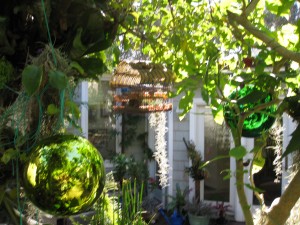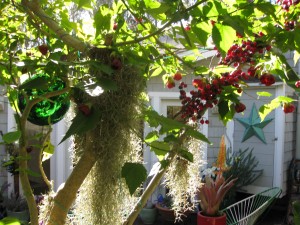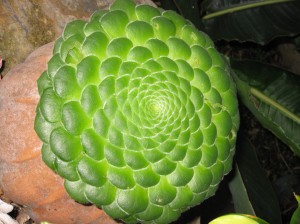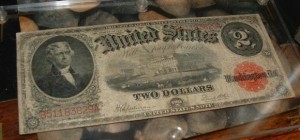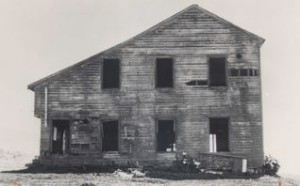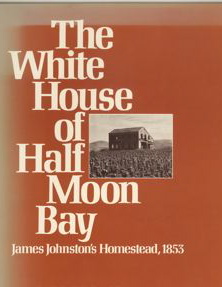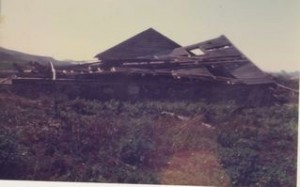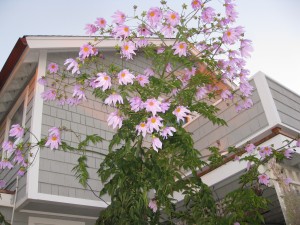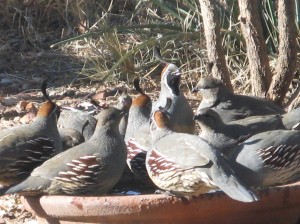Email Leon Kunke ([email protected])
1891: Frank Hendricks Calls HMB the “Gem of the Sea”
Half Moon Bay was originally a tiny village called San Benito. When it grew into a bigger village, it was known as “Spanishtown,” a 19th name that stuck with locals well into the 20th century.
In 1891, Coastsider Frank Hendricks penned a poem called:
“Spanishtown”
“I view the sea shore
“And hear int he distance
“The wild breakers roar,
“And down the green valley
“By fountain and tree
“There appears to my vision
“The Gem of the Sea.
“No costly reared mansions,
“Nor cloud piercing domes,
“Overlook in proud grandeur
“That cluster of homes,
“But where a warmth hearth and
“A welcome will be,
“I’ll return to that village;
“The Gem of the Sea.
“Upon the wide prairies
“A shelter was mine;
“I have dwelt in the shade of
“The cedar and pine;
“I have had many homes but
“The dearest to me
“Is that beautiful village,
“The Gem of the Sea.”
Green Dinner Plate: It’s a succulent!
Vanity Fair Wins The What’s Happening to Our Money Contest: They call it the “Great Repression”
A while back I posted my own contest trying to get a new label for the economic holocaust burning out of control. The winning term: Festering Economy.
The economy is still festering, turning into the dreaded carbuncle.
Now comes Vanity Fair magazine: Instead of the Great Depression 2, Vanity Fair magazine calls it the “Great Repression.” The “Great Repression” because the government isn’t revealing much of anything on the biggest financial crisis ever. Information on the real data is repressed.
The Washington-based press, in my opinion, is to be blamed as well, for not giving a “heads up” of any kind to the American people.
If you like to read political stories, the new issue of Vanity Fair has several good ones.
Sat. Nov. 22 Wilkinson School: I hear the sound of tom toms…
I live very close to the Wilkinson School. The school overlooks highway 1 at the Coronado signal light. I have actually lived on the same patch of land for almost 40 years. Ten more years and I qualify as a bona fide “local.”
When I first moved here, I was overjoyed to see a dirt road leading off Highway 1 into El Granada. A dirt road! With potholes and rocky bumps. On the opposite side of the highway, I saw the Pacific Ocean. Right there. I could almost touch the waves, feel the moist sand on my bare feet. For me, it was “paradise,” a description I hear lots of my neighbors use today.
My house was a funky beach bungalow, 800 square feet. Although there was a “new” indoor bathroom, there was also an outhouse in the backyard to remind me of how it was done in earlier days.
The bungalow had been built in 1950, one of the only houses on the block. Behind me the Pacinis, Italo and Rina, farmed. Now Rina, a widow, tends to a small orchard.
Rina Pacini’s neat little home has always reminded me of a small chapel. I hope it never gets torn down and replaced with something big and modern.
She knew Dante Dianda and John Patroni, respectively, the “Artichoke King” and the Prohibition “kingpin”. Dante’s immediate province was El Granada and Patroni was headquartered in Princeton-by-the=Sea. They also owned land together. Of the pair, John Patroni may have been the flashier, often seen driving his shiny black Cadillac around Half Moon Bay—a polite man who would stop to offer a ride to Rina.
Didn’t she tell me that her cozy house had been moved from the north side of El Granada to its permanent position near the Wilkinson and El Granada Schools? I think Dante helped with the move.
When I moved here, we called El Granada, “El Gray,” because the sky was rarely blue. Luckily, having grown up in the misnamed “Sunset District” of San Francisco, I grew to love fog. There I said it: I love fog.
I like a moody sky. Clouds, wind, rain….and sun, but not too hot.
Linda Wilkinson was living down the street when I started placing my collection of abalone shells in the garden. It looked funky but the Coastside was funky. That’s what I liked about it. The folks were real, no pretensions.
Linda Wilkinson’s home featured beautiful exterior rock work; it was the former home of a California legislator. Linda was teaching at El Granada School, and later, along with husband Ed, she opened a private school. The students took classes in the family home as well as in the blue buildings across the way from the house.
Although the Wilkinsons sold the house a few years ago, they continue to operate the school. And this Saturday, November 22, between 10 am & 2 pm, the Wilkinson School is hosting a “Hopi Arts & Culture Day,” with Bernard and Frances Dallasvuyaoma. For more info, please call 650.726.4582.
The Johnston House: It’s the Roof
When you travel south of town, you’ll see the Johnston House, on the hill to the east. It’s a famous architectural and cultural landmark, Cultural because James and Petra Johnston were of American and Spanish heritage (1850s.)
When I arrived here, the Johnston House was deserted. Its wood was gray and weathered. It was over 100 years old. The neighbor kids told me a ghost lived there; it was definitely a scary place.
Truth be told, hardly anybody drove up there although there was no one around to stop them.
As I recall–and I admit that memory distorts as we grow older–Deane & Deane/Westinghouse/Half Moon Bay Properties purchased the Corral de Tierra and the golf course near the Johnston House. Earlier, the house and surrounding land had been owned by the Cassinelli family. Through the decades many plans were floated for this property: San Francisco County Jail, College of San Mateo and as a possible home for the Giants baseball team.
When I was doing research (satisfying my own curiosity about the mysterious Coastside) at the county history museum in the 1970s, I came across historic work that had been done by someone working for Deane & Deane. It’s not often that land developers produce impressive historic materials but Deane & Deane did exactly that.
Via their historic research, a decision was made to “develop” the historic potential of the old farmhouse south of Half Moon Bay. The Johnston House. Renowned cultural historian C. Malcolm Watkins was brought in, and he lifted the dilapidated Johnston House out of obscurity. Mr. Watkins was fascinated with the idea of the Johnstons, James and Petra, and their origins, Ohio and South America, the perfect marital union that epitomized old California. Until bad times hit the Johnstons, the farmhouse was painted white and was visible to passengers in sailing ships That was the cultural historical part.
On the architectural front, Mr. Watkins noted the unusual roofline, and how time and again he had seen it on the East Coast but rarely on the West.
Back east builders called that design a “salbox roof,” which means the roof extended downward from a second floor to cover a first-floor addition. This was an inexpensive way of connecting two sections of a house without having to create a gutter between them.
I’ve always known the Johnston House as a “saltbox” but there’s another name for the roof: CATSLIDE ROOF. If you visit the Johnston House, let me know if you think a cat could slide down the roof.
C. Malcolm Watkins authored an excellent publication (1972) for the Johnston House Foundation called : The White House of Half Moon Bay: James Johnston’s Homestead, 1853. It is available at the San Mateo County Hitory Museum in Redwood City (650.299.0104.)
I know firsthand how long it took, from fundraising to restoring the house, not because I was personally involved; I was not, but because I watched the Johnston House virtually rise up after rivers of heavy Coastside winds blew it down. The farmhouse completely collapsed.
The Johnston House was rebuilt, and, while under construction, I remember visiting, amazed at the restoration, including period furniture in the rooms. There may be pieces that the Johnstons actually owned when they lived in the house. Petra Cooper, a descendent of the Johnstons was living in Redwood City at the time, and she was extremely helpful and excited about the restoration.
Today the Johnston House, once home to an early Coastside family, is an historic landmark. The saltbox looks out at us from the hill it stands on.
But what happened at the farmhouse during the years it was “down in the dumps?” Those are the stories we may never know.
Now & Then: Grizzly Bears and Mountain Lions
Last night I received this “Coastsider alert” from Coastsider.com:
A mountain lion was sighted at 4:30pm today in the area of Bernal Ave at
Ocean Ave in Moss Beach. If you see a mountain lion, contact the Sheriff’
at 911. or Sgt. R. Johnson at Moss Beach substation 573-2844.
There’s a map of the area on Coastsider:
Here’s a good story from Pescadero, May 2, 1862:
“Friday, the 11th inst., Thomas Dale, Rufus Morgan and others were in pursuit of a grizzly bear, which had been committing depredations on the San Gregoria and vicinity. Finding the bear, with two cubs, on the Pomponia, some two miles from this place, they succeeded in killing one of the cubs, and wounding the old bear in the neck, which retreated, as they supposed, down the hill to the creek. They had pursued but a few paces when they came upon her, and so suddenly that she succeeded in catching Rufus Morgan and mutilating him in so severe a manner that all hopes of recovery seemed impossible. Dr. Goodspeed was called and rendered immediate aid. Finding the skull badly fractured, by the bear biting him so as to tear away the temporal bone, opening to the brain–also destroying one eye, which eye, luckily, he had lost the use of some years since–and shockingly mangling his left arm and hand; the wounds were dressed by removing a portion of the superior maxilary bone, which was displaced. Dr. Goodspeed has hopes of recovery, if the wound should not be complicated with erysipelatous inflammation.”
Giant Dahlias Thrive in the Banana Belt
11 Quail on November 11
Coastsider.com: Pigeon Point lights up
To read the story, please go to coastsider.com

